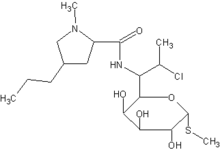Clindamycin
Clindamycin is a lincosamide antibiotic. Clindamycin is a semisynthetic antibiotic and derived from lincomycin by the addition of chloride. Clindamycin is sold under brand names such as Dalacin and Cleocin. It is most effective against infections involving the following types of organisms: more...
- Aerobic gram-positive cocci, including some members of the Staphylococcus and Streptococcus (eg. pneumococcus) genera.
- Anaerobic gram-negative bacilli, including some members of the Bacteroides and Fusobacterium genera.
It is used primarily to treat infections caused by susceptible anaerobic bacteria. Such infections might include respiratory infections, septicemia and peritonitis. In penicillin allergic patients clindamycin may be used to treat susceptible aerobic infections as well. It is also used to treat bone-infections caused by Staphylococcus aureus. Topical application of clindamycin phosphate can be used to treat severe acne.
Available forms
Clindamycin is commonly administered in penal caps as hydrochloride or in oral suspension as palmitate hydrochloride. It is also available for intravenous injection as phosphate. In topical preparations clindamycin is as hydrochloride or phosphate (Evoclin®).
Mechanism of action
Clindamycin has a bacteriostatic effect. Clindamycin interferes with bacterial protein synthesis, in a similar way as erythromycin and chloramphenicol, by binding to the 50S subunit of the bacterial ribosome. This causes antagonism if administered simultaneously and possible cross-resistance.
Pharmacokinetics
Almost all of orally administered clindamycin is absorbed from the gastro-intestinal tract, and it is widely distributed throughout the body, excluding the central nervous system. Clindamycin phosphate, as injection, is inactive, but it is rapidly hydrolysed in the blood to active clindamycin. High concentrations of clindamycin can be found in the bile (up 100 times higher than in the plasma). Adequate concentrations can also be found in the bone, and there is also active uptake into leucocytes.
Metabolism
Most of clindamycin is metabolised in the liver, and some of its metabolites are active, such as N-demethyl and sulphoxide-metabolites, and some are inactive. Clindamycin's half-life is 21 hours. Both active clindamycin and its metabolites are excreted primarily in the urine and some in the bile.
Side effects
Common side effects are mainly gastrointestinal disturbances. Clindamycin can cause a potentially lethal condition, pseudomembranous colitis, which is caused by Clostridium difficile, a clindamycin resistant bacteria (all the other bacteria have been killed by clindamycin, allowing C. difficile to over-proliferate and cause inflammation of the colon). Rare instances of polyarthritis (inflamation of several joints) have also been reported. In some cases this polyarthritis side effect feels like extreme flu-like aching througout the body.
Read more at Wikipedia.org



